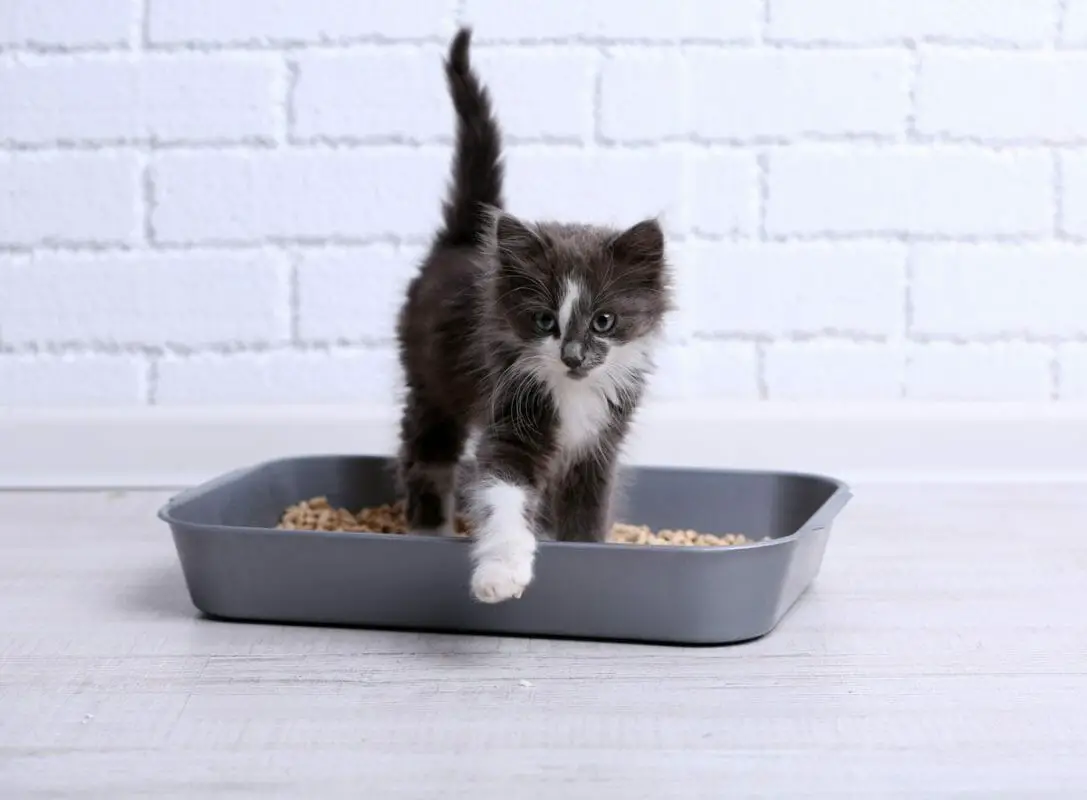Cats make adorable pets, and people just love cats – look at all the cat pictures on the Internet. They are happy to go outside, but at times when they are young and for their own safety they need to be inside and have somewhere to pee and poop. So cat litter tray is the obvious answer. The problem is that cat litter smell can be off-putting.
On the whole, an air purifier can reduce cat litter odor either with the litter in a box and ducting to the air purifier or having an air purifier close by to suck the air from over the cat litter into the air purifier. Which ever method you choose, the air purifier needs a good carbon filter.
Of course, if you are going to buy an air purifier, buy one with a true HEPA filter to also remove airborne particles and protect your health. A HEPA filter will remove 99.97% of airborne particles of 0.3 microns in diameter and even smaller particles. So a HEPA air purifier can easily remove pet dander, other allergens, mold spores, and even cat hair if the hair actually floats into the air purifier before falling to the floor. This removal of cat dander may help to some extent with cat allergies.
The type of HEPA air purifier that you need is determined by how you are going to use the air purifier to work with the cat litter, so we need to consider first the main 2 ways of using an air purifier with cat litter –
What Causes the Litter Odors That We Need Removed and How Does an Air Purifier Remove Them
The pet smell is caused by airborne pollutants, ammonia and volatile organic compounds, which evaporate into the air where you can smell them. The ammonia comes from the breakdown of urea from cat urine and causes that rather nasty smell of stale urine. Cat feces produce volatile organic compounds.
Only the volatile organic compounds can be removed by the activated carbon filter of an air purifier. These compounds diffuse into the air and in the air filter meet the activated carbon where they become stuck to it by weak intermolecular bonds. They are then trapped on the filter and so removed from the air, there is a helpful article on carbon filters here-“How air purifiers work“.
However, ammonia will not stick to the activated carbon filter. So we need another technique for removing the ammonia, this is done by using zeolite to absorb ammonium ions produced from the urine. This then limits the release of ammonia into the air. This is outlined in the “anything else” section below.
How to Use an Air Purifier With a Cat Litter Tray
Connection of Litter Box to Air Purifier
a) Air Purifier Near the Cat Litter
Simply place the air purifier next to the cat litter box and switch it on. The air will be sucked into the air purifier and the volatile organic compounds causing the odor removed. Not all the VOCs will be removed on the first pass through the air purifier, but the amount will be diminished.
b) “Box With Ducting”
In this YouTube video the cat litter is in a box with tubing going straight to an air purifier.
In the next YouTube video, the venting duct is connected to the outside. However it could be connected to an air purifier in an easier way than the above YouTube video. This could be done by taping the opening of a plastic bag around part of the air inlet of the air purifier, and then inserting the tube into the other end of the plastic bag and securing with tape.
Even easier is to simply directly connect the venting duct to a grow tent fan and carbon filter as these are made to join onto this type of tubing. A grow tent carbon filter also contains much more activated carbon than an air purifier.
A great thing about this arrangement is that you can see when the litter needs changing.
Speed Setting
The speed setting depends on how you are going to connect the air purifier to the litter.
a) Air Purifier Near the Litter Tray
If you use this method for using an air purifier to reduce the smell of cat litter, then you will need to have the air purifier on a high setting. This is because you are relying on the suction from the air purifier to stop the volatile organic compounds causing the odor diffusing into the room from the cat litter. So you need quite a powerful draft of the air from over the cat litter going into the air purifier. It would be best to aim for 5 air changes per hour as per EPA guidance. An air change occurs when a volume of air the size of the room goes through the air purifier once. This means that you need to buy an air purifier that is powerful enough.

Please see this article for further details-“Buying an Air Purifier“
b) Box With Ducting
If you use the box method above then really you need the air purifier on a slow setting. This is to allow a good time for the air to be in contact with the activated carbon filter. As the time the air is in contact with the activated carbon increases, the more of the volatile organic chemicals causing the odor will be removed from the air.
Air Purifier Selection
| Feature Needed | Reason |
|---|---|
| A good amount of activated Carbon | The more odor absorption capacity the better |
| A fairly tall air purifier | To maximize the chance of sucking in air with odors, the taller the better so that any air that is missed at a lower level will be sucked in at a higher level |
| An air intake that is wide | The wider the intake the wider the litter tray that the air purifier can deal with satisfactorily |
| An air intake that is flat | So that when the air intake is next to the cat litter all parts of the intake is as close as possible to the litter tray. This gives the best uniform air flow over the cat litter and into the air purifier. If the air purifier is a cylinder then one part of the intake will be close to the litter but other parts more distant and some parts will be taking in air from the opposite direction to the cat litter! |
| An air intake on just one side | The air intake needs to be on one side of the machine so that all the intake air is sucked in over the cat litter. Some air purifiers have intakes on 2 sides of the machine. |
| Air intake not underneath the machine | Many air purifiers especially the cheaper circular ones have air intakes under the machine. This will be below the level of the cat litter and so will not be as effective as an air purifier that is sucking in air over the top of the air purifier. |
| A configuration that will allow ducting to be attached and still have access to the filters for replacement | This is to give you the option of starting by using the air purifier simply near the litter tray and then swopping to the “box with ducting method” if you want. |
So an excellent air purifier that meets all these criteria is the Winix AM90-
Best Air Purifier for Cat Litter-the Winix AM90
Winix AM90
This is the replacement for the Winix 5500 air cleaner and has the advantage of smart Wi-Fi control. For sleeping, this air purifier can be only be recommended for bedrooms up to 145 sq ft as the noise level to serve a room of this size is 36db.
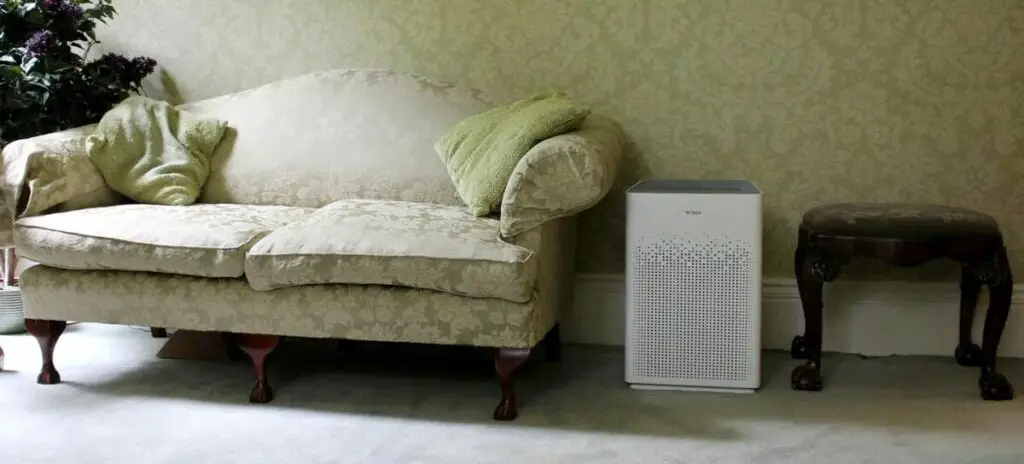
| Filters | |
| HEPA filter | HEPA 13 filter |
| Carbon filter amount of carbon | Small amount of carbon incorporated into main filter 0.1 lb |
| Filter Change HEPA (Particles) | 12 months |
| Filter Change Carbon (Chemicals) | 3 months |
| Airflow | |
| CADR at 36db | 94 cfm |
| Maximum Bedroom Size* | 145 sq ft |
| Maximum Room Size (On noisiest setting) | 360 sq ft |
| Smart Control | Smart Phone App |
| Power | 65 W |
| Weight | 15.8 lb |
| Dimensions “H x “W x D” | 23.5 x 8.7 x 15.1 inches |
| Annual Running Cost Electricity | $20 |
| Annual Running Cost Filters | $80 |
| Total Annual Running Cost | $100 |
All the above are approximate and assume running the air purifier for 12 hours per day on the highest setting that keeps the noise below the level specified in db in the table. This is less than or equal to 50db in normal daytime use and 35db for bedrooms.
*Most people will not wish to have the air purifier on a setting louder than about 35db for sleeping in a bedroom-you may wish to have a quieter setting than 35db this is just a ballpark estimate for most people. On the other hand, if your room layout allows you to be much further than 6 feet from the air purifier you may find the noise this machine makes at top speed is alright. The calculations for room size assume that you have 8 foot ceilings and 5 air changes per hour.
Never run an air purifier on auto mode using the inbuilt sensor. These cannot detect ultrafine particles which are damaging to human health, please see this article- How to test the air quality in your home.
The carbon filter of the Winix AM90 as less activated carbon than the Coway but it is more evenly distributed over the filter and so does not suffer the problem that modern carbon filter configuration does when used for cat litter. Also over the course of the year 4 filters will be used whereas for the Coway only one filter will be used. So the amount of carbon in each filter needs to be multiply by 4 to give the amount of carbon that be used in one year.
This is the replacement for the Winix 5500 air cleaner and has the advantage of smart Wi-Fi control. For sleeping, this air purifier can be only be recommended for bedrooms up to 145 sq ft as the noise level to serve a room of this size is 36db.
So why not buy the Winix HR900 “Ultimate Pet” 5-Stage True HEPA Air Purifier? There are 4 reasons why you may take the view that the AM90 is a better choice-
- The Winix AM90 is cheaper currently $150 cheaper
- The filters for the AM90 are currently $40 cheaper per year
- The AM90 covers a greater room area, as verified by AHAM Verifide 360 sq ft versus 300 sq ft for the HR900
- The AM90 arguably has a better distribution of carbon in the carbon filter for removing odors. The HR900 filter is as outlined in the illustration below “Modern carbon filter configuration”.
- The AM90 is “smart” is WIFI controllable the HR900 is not smart.
The extra feature that the HR 900 has is an additional pre-filter. This makes no difference to the quality of the air leaving the air purifier–the rate-limiting step for air quality is the HEPA filter. The HEPA filter will catch any particles that are pre-filter will capture. The purpose of the pre-filter is to stop so many large particles from getting to the HEPA filter. However, it is doubtful that this is a significant advantage as the carbon filter in the AM90 is acting partly as a pre-filter and is replaced every 3 months, this is not the case in the HR 900.
Also good-
Coway AP-1512 HHS (cheaper but lower air flow and noisier than the Coway 400s)
Careful! this is the newer version of the Coway AP-1512 so look for the “S” on the end of the code number. It is not only smart but also uses different upgraded filters.
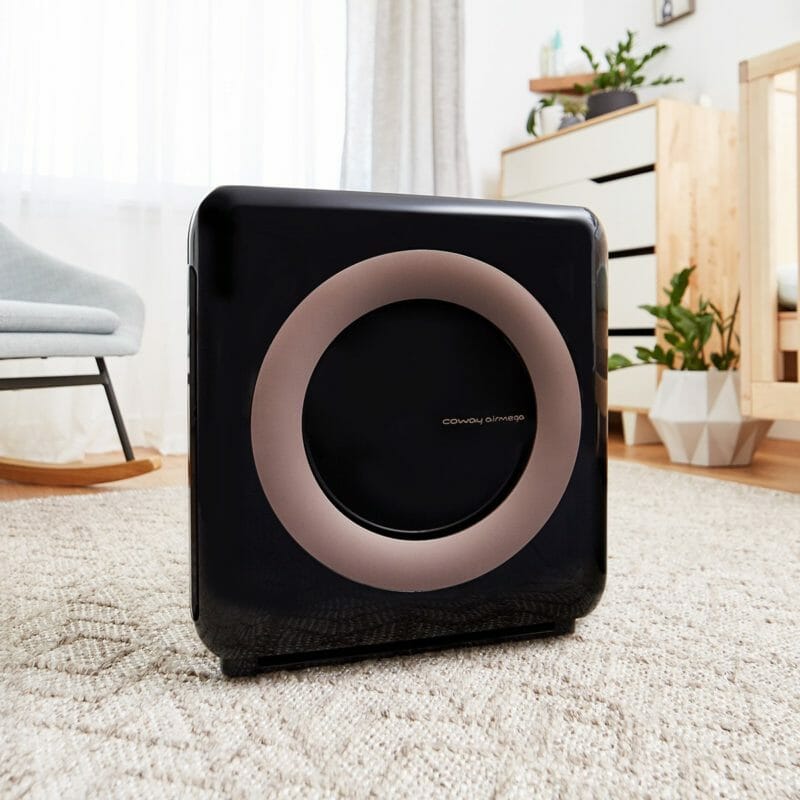
| Filters | |
| HEPA filter | HEPA specified to remove 99.8% of ultrafine particles down to a size of 0.010um |
| Carbon filter amount of carbon (lb) | 0.75 lb |
| Filter Change HEPA (Particles) | 12 months |
| Filter Change Carbon (Chemicals) | 12 months |
| Airflow | |
| CADR at =<50db (CADR on Maximum) | 139 cfm |
| Maximum Room Size (Noise less than 50db*) | 214 sq ft |
| Maximum Room Size (On noisiest setting) | 370 sq ft |
| Smart Control | Yes WIFI |
| Power | 80 W |
| Weight | 12 lbs |
| Dimensions “H x “W x D” | 17 x 18 x 10 |
| Annual Running Cost Electricity ($) | $50 |
| Annual Running Cost Filters ($) | $70 |
| Total Annual Running Cost ($) | $120 |
One problem with a more modern arrangement of carbon in the filter is outlined in the illustration below. To get a greater amount of high-quality carbon into the filters without increasing the resistance to airflow too much a honeycomb lattice where each cell is partly filled with carbon is increasingly used. For most purposes this is excellent. However, for cat litter it is not. this is because the smell is so pungent that we really want all the air to come into contact with carbon on its very first pass through the air purifier and be removed. We do not really want the air purifier to be distributing cat litter smell with a high air flow all over the room. If this does happen it may of course be removed when it goes through the air purifier again but it would obviously be better to remove as much as possible on the first pass through.
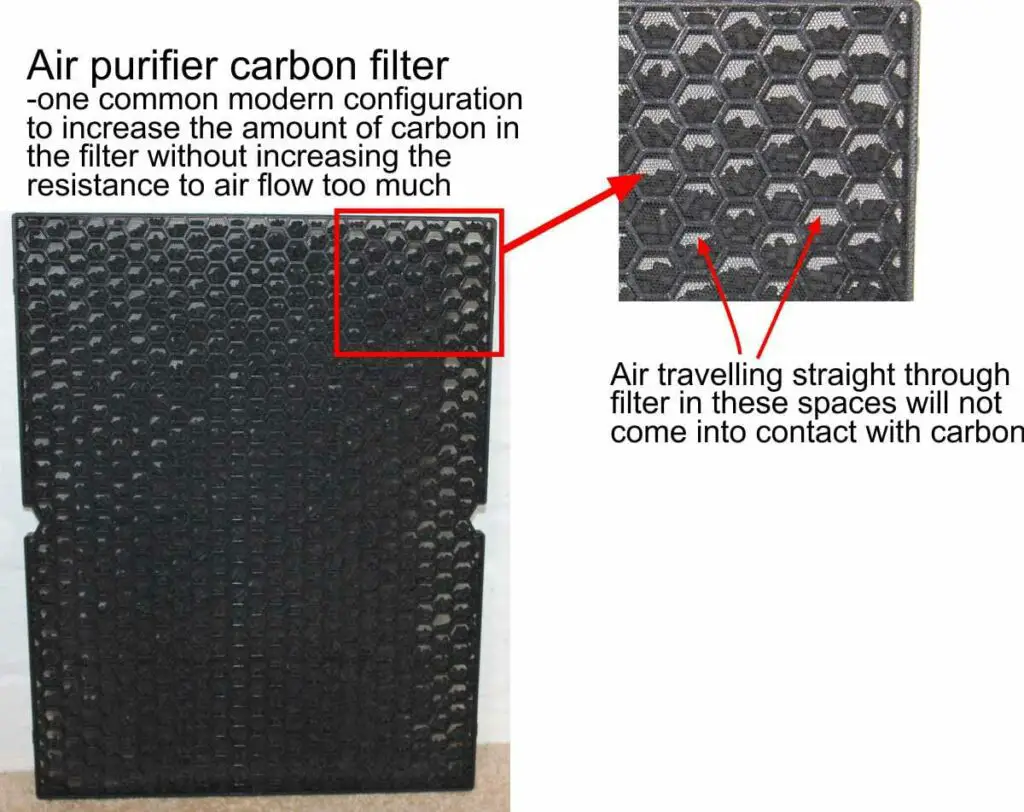
Dust From Cat Litter
An air purifier with a HEPA filter will be excellent at dealing with any dust from cat litter. HEPA filters are specified to reduce 0.3 micrometres diameter particles by 99.97%, but they also reduce other particles both larger and smaller by even more. With very small ultrafine particles, less than 0.04 micrometres, their performance is variable particularly depending on speed of airflow.
Wear a Mask When Handling Cat Litter
Clay-based litter contains crystalline silica. When silica is inhaled it can damage the lungs causing silicosis, but you are unlikely to inhale enough from cats litter to cause this. However, it may potentially be a carcinogen.
Cat litter contaminated with urine and feces can also contain pathogens that affect humans. Amongst these are bacteria and more famously, Toxoplasmosis Gondi.
Toxoplasmosis can lead to effects on the brain, causing mental health problems. It can also lead to blindness. An initial infection can cause headaches, fevers and aches in general.
Because of these potential problems with cat litter dust, even when fresh but particularly when contaminated with feces and urine, it is best to wear a mask that will remove particles when handling the litter.
The best mask is an elastomeric mask with N100 or P100 filters. There is a helpful article on this here-“What is the best air purifying mask?“
An air purifier will lessen the risk of infection from the cat litter.
Your Cat Will Benefit From an Air Purifier
Cats are particularly prone to respiratory problems and so your cat will also benefit from an air purifier reducing airborne particles in the home.
Apart From an Air Purifier What Else Will Help With Cat Litter?
There are other things that you can do to tremendously reduce the odor coming from cat litter-
- Use clumping litter, this clumps around and seals cat excrement so sealing it in and minimizing odors.
- Nature’s Miracle Just for Cats Odor Destroyer Litter Powder-very highly reviewed solution to reduce odors from cat litter. It contains Zeolite which can absorb ammonium ions and reduce the release of the ammonia, which is a product of the degradation of urea in urine and which causes an unpleasant odor of stale urine.
- Fresh Wave odor removing gel is a very effective deodorizer. This contains a super-absorbing polymer, plant oils and surfactant. Again great reviews.
- Change cat litter regularly, ideally twice a week, but at least once per week.
- Put the cat litter in a room that is separate from the rest of the house
Try not to use an air “freshener”, as this is simply putting more chemicals into the indoor air to mask the pet odor. You and your family will then breathe in these additional chemicals. So it reduces your air quality.
Alternative to an Air Purifier for Cat Litter Odor Control
A very cheap way to put air through a lot of activated carbon is to use a grow tent filter and fan. These filters have far more activated carbon than an air purifier and cost $60-100. If you do decide to buy one of these be careful to get one with a speed control so that you can vary the airflow to get the best setting for reducing odor whilst not being too loud. The replacement filters would be $30 every 12-18 months and this gives you much more carbon per dollar than an air purifier.
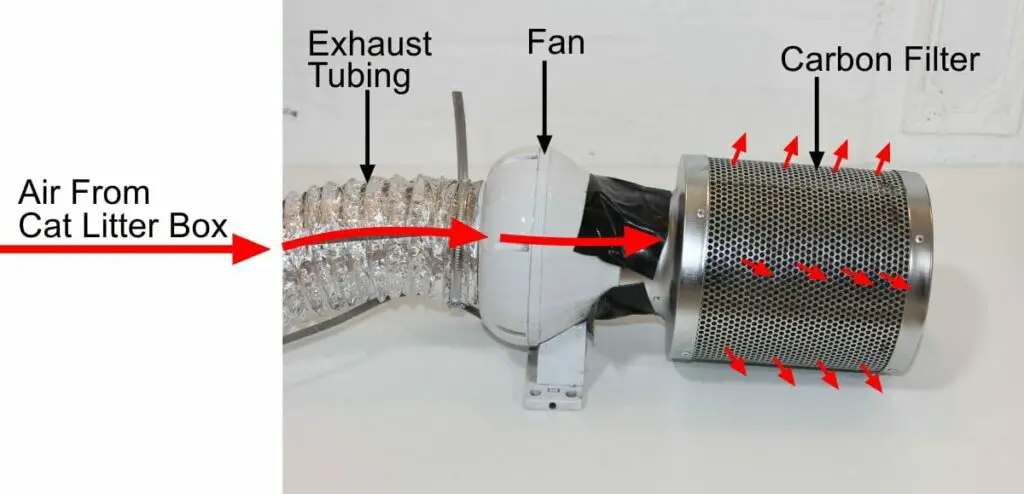
| Chemical Removing Capacity | Amount of Activated Carbon in Filter |
| iQair Multigas | 12lb |
| iQair HealthPro Plus | 5lb |
| Orsani EJ120 | 3.5lb* or 1lb |
| Coway 400S | 1.5lb |
| Small cheap air purifier | 0.1lb |
As you can see, these setups are cheap. They also ensure that all the air comes into contact with a thick layer of activated carbon. This is not always the case with air purifier filters as you can see from this image –
So some air will go through the air purifier without contact with the activated charcoal each time the air goes through the filter.
The disadvantages of this approach are-
- it needs some DIY skills. It really needs to have the cat litter in an enclosed box and connect the tubing to the box. An example of this type of setup is seen in the YouTube video above with the transparent box. Rather than have the tubing to the outside as seen in the YouTube video, the tubing would simply go to the carbon filter. The sensor to activate the fan for a set time after the cat uses the litter tray is a nice touch. If you have an existing covered litter tray, you could simply cut a hole in the top.
- All the air goes through the carbon, there is no missing the carbon.
- Not as neat as an air purifier.
- you miss out on an important aspect of air purification, as the airborne particle filtration is nowhere near as good as with an air purifier.
The lack of particle filtration is a really significant downside of this approach compared to an air purifier as airborne particles impact human health-please see this article. However, to achieve good particle reduction you would have to have a large enough air purifier, run it on a high enough setting and check particle count reduction to make sure that you are being effective.
Will an air purifier get rid of cat urine smell?
On the whole, an air purifier is least effective at getting rid of cat urine smell. Much of the smell is due to ammonia which the activated carbon “chemical” filter of the air purifier, cannot remove. It will remove some of the volatile organic compounds causing the urine smell not really pungent ammonia smell. For that will need a product with zeolite which absorbs ammonium ions, such as Nature’s Miracle Just for Cats Odor.
Will an air purifier help with cat litter box smells?
As a general rule, an air purifier is very helpful for cat litter box smells. The air purifier’s activated carbon filter will absorb most of the different types of chemical causing the smells. One weak point is that it will not reduce the pungent smell due to ammonia as active carbon does not bind ammonia. Ammonia can be removed by adding zeolite to the cat litter
How do you choose the best air purifiers for cat litter dust?
A HEPA air purifier with a carbon filter is the best type of air purifier for cat litter dust. The HEPA filter must be a true HEPA filter not “HEPA like, 99% HEPA, HEPA style…”. This will effectively remove 99.97% or more of dust particles from cat litter.
If you do choose to buy an air purifier for your cat litter-here are some important points-
In one review of studies where air purifiers were used, fine particulate matter was reduced between 23-92%. Bear in mind the EPA recommends a minimum reduction of 80%. So even in experimental studies with training in how to use the air purifiers, most air purifier users failed to hit this target. On the other hand, it shows that air purifiers, when used well, can decrease particle count by 90%. This just emphasizes the importance of how you use the air purifier.
- Buying an air purifier-the air purifier should have a true HEPA filter, adequate air flow (CADR) at a noise that you can tolerate for long periods. The air purifier should be “smart” that is programmable or capable of being made smart. The most difficult part is buying one with an adequate air flow at a noise that you can tolerate for long periods as most air purifiers are too loud on their maximum fan speed and manufacturers usually do not give data on air flow and noise at lower fan speeds. There is helpful advice about buying an air purifier here-“Buying an air purifier”. Alternatively, just buy the recommendations on this site. If you want the quietest air purifier you may wish to read this article-“Best Quiet Air Purifiers“, if you need one that will remove particles very well but is particularly good at removing chemicals from the air, for example from forest fires, please see this article-“Best Air Purifier for Smoke“.
- Position the air purifier at least 12 inches from any wall-so that the air coming out of the air purifier joins in with the circulation of air in the room. There is advice about using an air purifier in this article-“How to Use an Air Purifier“.
- Run the air purifier for at least 30 minutes before entering the room. This is because it takes an air purifier this long to reduce the particle count in the room. So the air purifier that you buy needs to be smart or capable of being made smart by plugging it into a smart plug.
- Run the air purifier continuously when you are in the room at the highest setting that you can tolerate long term. This is because the higher the setting that you run the air purifier on the lower the particle count in the air will be. There is no lower threshold known below which human health does not improve, so the lower the particle count/PM2.5 the better. Health aspects of particle count/PM2.5 are outlined in this article-“Airborne Particles and Chemicals Affect Us All Now“.
- Never run the air purifier using its inbuilt sensor-there are 7 reasons that you should not do this as outlined in this article-“How to Use an Air Purifier“.
- Always test the air with an air quality meter where you are going to sit at the height in the room where your mouth and nose are. Comparing the measurements before and 45 minutes after switching the air purifier on there should be at least an 80% reduction in particle count as the EPA recommends. Testing that the particle count/PM2.5 is adequately reduced by your air purifier is the most important thing that you need to do. Air quality meters can be brought really quite cheaply eg $35, there is a helpful article about them here-“How to Test Air Quality in Your Home“.
- How many air purifiers do I need?-at least 2 but maybe 5 or more. Please see this article “How many air purifiers“.
Conclusion
An air purifier for cat litter is a great way to remove litter box smell and cat odor in general. The cheapest air purifiers have very little activated carbon to remove volatile organic compounds which cause the odor of the air. So you would need to spend $150 upwards. The replacement carbon filters will cost $25 a year using generic filters. It also has the advantage of great airborne particle filtration, helping preserve your health, providing that you buy an air purifier with a true-HEPA filter.
Although you could connect the air purifier to a box with the litter in, you may wish to start by simply positioning the air purifier next to the cat litter tray and switching it on.
A much cheaper system in terms of weight of activated carbon per dollar is to use a grow tent fan and carbon filter. This would cost about $60, and approximately $30 per year for a replacement filter. However, this needs some DIY setup. With this option, you also miss out on airborne particle filtration.
Whichever choice you make, you will still need to use something to combat the ammonia smell from stale urine as an activated carbon filter cannot remove ammonia-Nature’s Miracle Just for Cats Odor Destroyer Litter Powder would be a great choice.
Related Questions
Related Posts
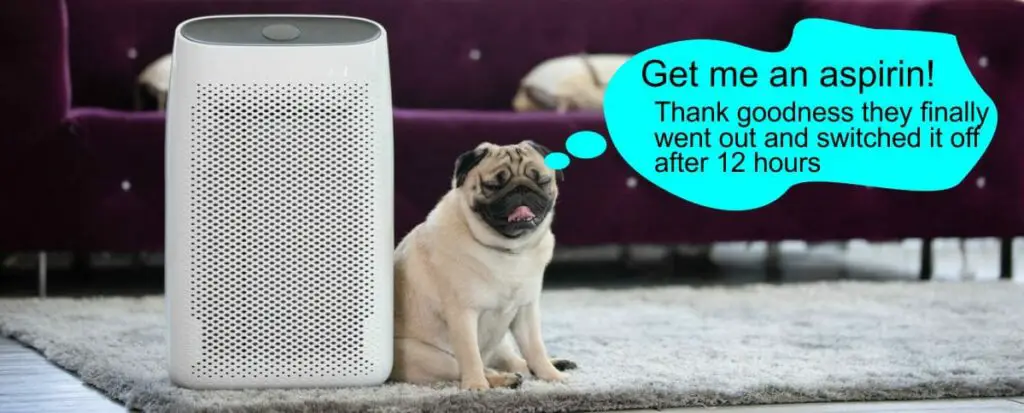
Best Air Purifier for a Kitchen


